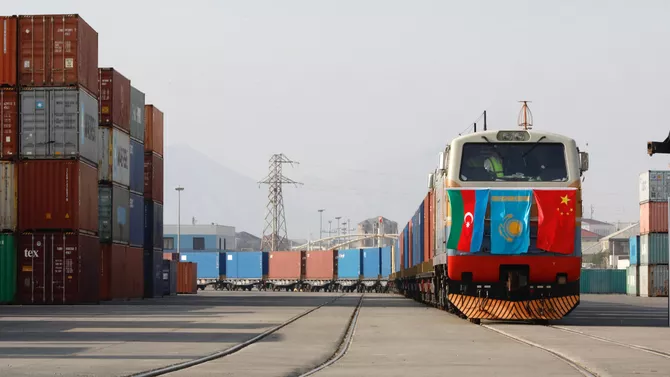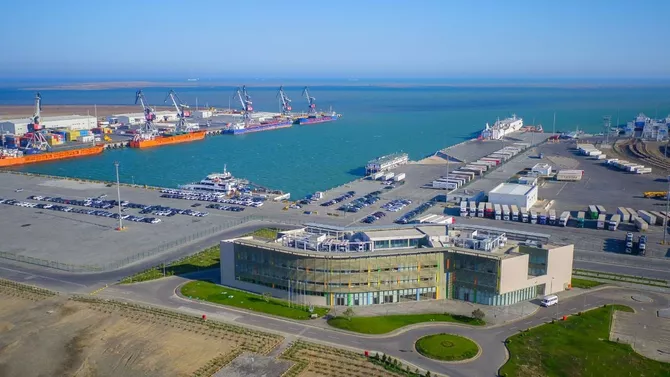
Photo credit: rail-news.kz
The strategic partnership between Kazakhstan and Azerbaijan has emerged as a cornerstone of cooperation in the South Caucasus and Central Asia, reflecting a shared vision for regional connectivity, stability, and economic progress. Built on mutual trust and pragmatic diplomacy, the relationship between Astana and Baku goes beyond traditional bilateral ties, embracing a comprehensive agenda that spans transport, energy, trade, and digital integration.
At the heart of this cooperation lies the Trans-Caspian International Transport Route (TITR), also known as the Middle Corridor, which positions the two nations as vital links between China and Europe. As both sides deepen collaboration within the Organization of Turkic States (OTS), their joint efforts in maritime infrastructure, logistics, and fiber-optic communication projects demonstrate a forward-looking approach. In 2025, these initiatives have transformed Kazakhstan-Azerbaijan relations into a dynamic model of interregional connectivity and strategic economic partnership.
In an interview with The Caspian Post, Lidiya Parkhomchik, an expert at the Institute of World Economy and Politics of Kazakhstan, emphasized that “for Kazakhstan, Azerbaijan is a key partner in the South Caucasus.”
According to her, Astana has always regarded its relations with Baku as “strategic and allied in nature.” Parkhomchik pointed out that the Kazakhstan-Azerbaijan partnership stands out in the region as a “rare case of cooperation built upon mutual trust and shared interests.” She noted that both countries consistently adhere to the principles of a multi-vector foreign policy and economic pragmatism, which has helped maintain steady bilateral engagement even amid global challenges.

Photo credit: corp.ady.az
Speaking about economic dynamics, the Kazakh expert underlined that “2025 has demonstrated that it is indeed realistic to achieve the key goal set by both presidents, namely, to increase bilateral trade turnover to $1 billion.”
She also recalled that, despite periods of fluctuation, trade between the two nations traditionally hovered around the $500 million mark, with some years seeing declines to below $200 million. These downturns, according to Parkhomchik, “highlighted the importance of developing anchor economic projects capable of attracting investment and trade.”
Among such projects, Parkhomchik particularly stressed the strategic significance of the Middle Corridor, describing it as “an indisputable anchor project for both Kazakhstan and Azerbaijan.”
She highlighted that “Azerbaijan serves as a strategic hub along the China-Europe transport axis,” and that Kazakhstan, Azerbaijan, and Turkey have become the driving forces behind the development of this trans-Eurasian corridor.
“If in 2017 the volume of cargo transported via the TITR was only 1.3 million tons, today this figure has nearly tripled to 3.5 million tons,” the expert said, pointing to impressive progress. The corridor’s capacity, she added, could rise to 10 million tons annually after ongoing modernization efforts.
Parkhomchik drew attention to the deepening maritime cooperation between the Aktau and Alat ports. “In 2022, an agreement of intent was signed to establish a Kazakh logistics terminal within the Azerbaijani port,” she said, adding that this initiative has already materialized through a partnership involving Samruk-Kazyna, Kazakhstan Temir Zholy, and the Baku International Sea Trade Port.

Baku port / Credit: businesslend.com
She also noted that “construction of a container hub in the port of Aktau has been completed,” which will further enhance Trans-Caspian throughput capacity.
The expert underscored the growing role of energy cooperation, especially through the Baku-Tbilisi-Ceyhan (BTC) pipeline. “This route enables Kazakhstan to diversify its export paths,” Parkhomchik explained. Plans are already in place to raise oil transit volumes via BTC to 7 million tons by 2027, up from the current 1.5 million tons, she said.
Looking ahead, she highlighted that “by 2026, Kazakhstan and Azerbaijan aim to ensure not only the transit of hydrocarbons and containers but also digital data.” The construction of a fiber-optic line between Aktau and Baku is expected to strengthen digital connectivity across the Caspian region.
“Trans-Caspian cooperation forms the backbone of trade and joint projects between the two nations,” according to Parkhomchik. She believes that the recently established joint investment fund under the Astana International Financial Center (AIFC) is a clear indicator of both sides’ determination to “expand mechanisms for intensifying trade and economic collaboration.”
In conclusion, the expert noted that Kazakhstan and Azerbaijan are steadily transforming their partnership from traditional trade interaction into a comprehensive strategic alliance, covering logistics, energy, and digital connectivity - a cooperation model rooted in mutual benefit and long-term vision.
Share on social media